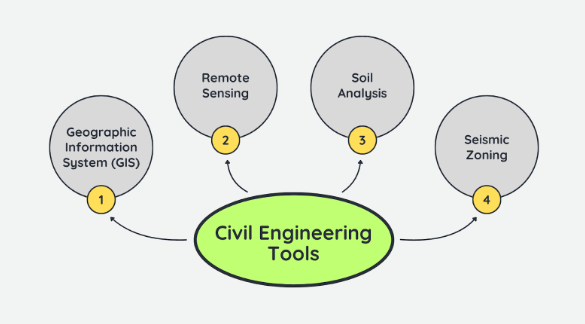Tackling Future Disasters with B.Tech. Civil Engineering - Where Systems, Society, and Sustainability Converge

Blog / July 22, 2025
civil engineering courseB.Tech. Civil EngineeringInfrastructure rarely fails without warning. Cracks begin long before collapse, in materials, in systems, or in the assumptions behind their design. In floodplains, on seismic faults, across unstable slopes: failure begins where engineering ends. Civil engineers are trained to address these infrastructural failures before they escalate.
B.Tech. Civil Engineering syllabus is built around this principle. With subjects like soil mechanics, hydrology, transportation, risk mitigation, etc, it prepares students to work across the full span of infrastructure, including dams, bridges, transport systems, water supply networks, buildings, etc. Going one step further, the B.Tech. Civil Engineering subjects equip students with the knowledge and tools to assess risk, design for durability, and respond to evolving environmental stresses.

Designing for Prevention: How Civil Engineers Anticipate Risks Before They Strike
One does not need to see the damage to know the danger. Civil engineers begin their work by thinking ahead.
Prevention is built into every plan. And that plan starts with risk analysis. What are these preventive actions?
- Topography analysis to check slopes, soil, and flood paths
- Hydrological studies to understand water flow and flood risk
- Seismic mapping to assess how stable the ground is
- Urban drainage modelling to avoid waterlogging and surface flooding
These include AI-based flood modelling, stormwater simulation, and geospatial data analysis, all of which help determine how and where potential disasters might unfold, long before they do.
The B.Tech. Civil Engineering subjects today reflect this shift. Topics like disaster management, environmental systems, and geotechnical engineering are no longer optional; they are essential. Apart from this, they get trained for using various tools, like:
|
Tool/Method |
Purpose |
|
GIS (Geographic Information System) |
Mapping terrain, floods, risk zones |
|
Remote Sensing |
Satellite data for disaster prediction |
|
Soil Analysis |
Foundation safety and landslide prevention |
|
Seismic Zoning |
Earthquake-resilient construction planning |
Full-Cycle Impact: How Civil Engineers Help Before, During, and After Disasters
Stopping a disaster isn’t a one-step task.
Civil engineers work across the full disaster management cycle. That means before the event, during the crisis, and after the dust settles.
Let’s break it down.
1. Mitigation: Reducing the Risk Before It Happens
This includes designing floodwalls, earthquake-resistant buildings, and safe stormwater systems. In India, this phase covers things like:
- Building earthquake-safe schools in the Himalayan zones
- Planning drainage in coastal cities like Chennai or Mumbai
- Designing roads on slopes to prevent landslides
In Uttarakhand, engineers used slope stabilization and bioengineering to protect villages vulnerable to landslides. Reinforced soil walls and vegetation now shield roads and homes during the monsoon.
2. Preparedness: Getting Systems and People Ready
Preparedness isn’t just about drills. Civil engineers assess which buildings can become shelters. They plan escape routes. They build warning systems into infrastructure.
3. Response: Acting When Disaster Strikes
This is where speed matters. Structures collapse. Roads break. Access is lost.
In the 2016 Ecuador earthquake, engineers evaluated buildings for safety within hours. These rapid assessments decide who can return home and who must stay out.
4. Recovery: Rebuilding, Safer, and Smarter
Recovery isn't just restoring; it’s reimagining.
For example, in 2005, after a deadly earthquake in Pakistan, over Bailey Bridges were deployed to reconnect communities. Originally developed in World War II, these modular bridges are still saving lives.
Recovery needs to be planned at two levels: one for immediate relief and the second to build a resilient infrastructure that can survive any future crisis.
After the 2001 Bhuj earthquake, the Gujarat government led a massive reconstruction plan. Civil engineers redesigned housing layouts, widened roads for evacuation, and adopted new seismic codes. This is an absolutely outstanding example of long-term planning which has now become a model for urban rebuilding under disaster risk reduction strategies.
Disaster Recovery Projects That Shaped Modern Civil Engineering
When disaster strikes, the world notices those who step in. Civil engineers often lead that response, not just with tools, but with ideas that turn damage into design breakthroughs.
These examples show how real projects became problem-solving models for future engineers.
London's Victorian Sewer System
In the mid-1800s, London faced a deadly health crisis.
The Thames had become an open sewer. Over 10,000 people died from cholera in a single outbreak. One engineer, Joseph Bazalgette, was tasked with fixing it.
He didn’t just create a system to treat sewage; he built 82 miles of intercepting sewers and 1,100 miles of street sewers, using Portland cement with brickwork in egg-shaped tunnels designed to resist erosion and blockage that would last for centuries.
His design was so forward-thinking that much of it still works today. It’s now studied in environmental engineering and urban sanitation as a textbook case in B.Tech. Civil Engineering subjects.
Cordouan Lighthouse in France
Built in the 16th century and later improved with rotating Fresnel lenses, this lighthouse made ships visible up to 20 miles away.
This was one of the first times civil engineering mixed design, durability, and safety in a marine setting. They didn’t just light up coastlines. They reduced shipwrecks, saved trade, and protected lives.
Both the projects mentioned above solved more than one issue.
Civil engineers did not wait for policies or budgets. They worked within tight timelines and still delivered safety, stability, and scalability.
How the B.Tech. Civil Engineering Syllabus Prepares Students to Handle Crises and Build Resilient Infrastructure
Students often ask whether classroom learning can match the scale of real-life disasters. In B.Tech. Civil Engineering, the answer is yes, when the syllabus is aligned with the world’s challenges.
The course doesn’t just cover concrete and steel. It includes core B.Tech. Civil Engineering subjects like:
- Disaster Management
- Structural Analysis
- Environmental Engineering
- Geotechnical Engineering and
- Hydrology and Water Resources
These subjects train students to plan for earthquakes, floods, and urban risks. Through lab work, simulations, and field visits, one learns to assess risk, test materials, and design for durability.
By the time students graduate, they’ve practiced how to plan safer cities and build for uncertain futures. The B.Tech. Civil Engineering syllabus is designed to create professionals who don’t just build, but protect lives while doing it.
Engineer Resilience, Design Impact - Start at Shiv Nadar University (Institution of Eminence)
The real measure of a civil engineering program lies not in what it teaches, but in how it prepares students to think. In the School of Engineering at Shiv Nadar University, civil engineering education begins with a single premise: that infrastructure must do more than stand, it must endure, adapt, and serve.
B.Tech. Civil Engineering program here is designed with a clear intent, structured to meet the demands of the modern world. Students engage deeply with structural mechanics, geotechnics, and hydrology, but also explore climate adaptation, cyber-physical infrastructure, and real-world disaster management.
Three specialization tracks, viz, Sustainable Infrastructure Systems, Water, Environment and Climate, and Urban Network Systems, allow students to tailor their learning toward the most urgent global challenges.
At every stage, the emphasis is on systems thinking, research orientation, and public impact. Students are not just prepared to calculate loads or pour concrete. They’re trained to solve problems before they become crises, and to build structures that remain relevant long after the blueprint is approved.
Explore the B.Tech. Civil Engineering program at Shiv Nadar University and take the first step toward designing a safer, smarter world.
Conclusion
Civil engineers shape how societies prepare, respond, and recover when infrastructure is pushed to its limits. Long before a crisis begins, they assess weak points and design systems that can stand strong in unfavorable situations. Whether it’s preventing flood damage or ensuring clean water reaches every home, the impact is lasting. A well-designed B.Tech. Civil Engineering program must teach more than equations. It must train students to think ahead, act fast, and build with purpose. Shiv Nadar University offers exactly that.
FAQs
What do civil engineers do before a disaster happens?
They use risk maps, terrain analysis, and smart tools to design safe buildings, bridges, and cities. This includes earthquake zones, flood plains, and coastal areas.
What makes B.Tech. Civil Engineering different from other branches?
This field focuses on how physical infrastructure works with people and the planet. It combines structural science with community impact.
Is this a good career path for future-readiness?
Absolutely. It’s one of the few careers tied to global safety, smart cities, and climate resilience. Civil engineers are at the heart of sustainable development.